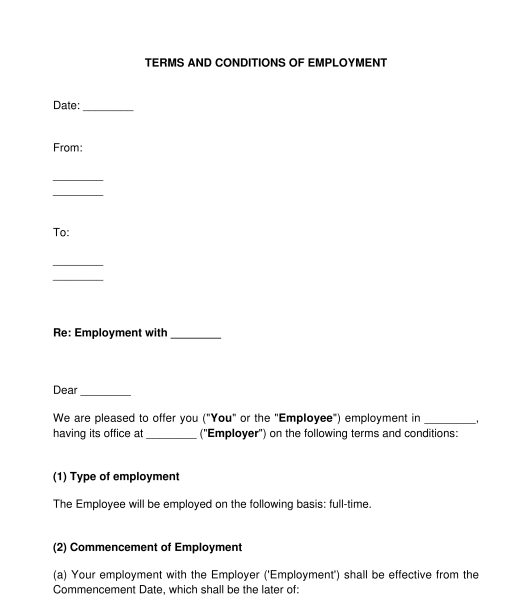 20-09-2025
20-09-2025

Answer a few questions and your document is created automatically.

Your document is ready! You will receive it in Word and PDF formats. You will be able to modify it.




Rating: 4.6 - 54 votes
Fill out the templateThe Employment Agreement is a legally binding contract that outlines the terms and conditions of employment between an employer and an employee. It serves as a crucial document when a business brings a new employee on board. It is designed to be flexible and can be tailored to suit different employment arrangements, including full-time, part-time, and fixed-term employment.
In many cases, once an employer chooses to take on a new employee, the parties want to get started without delay. Therefore, the employer may wish to provide the employee with a letter that spells out some key terms more briefly. Employers may wish to use an Offer Letter for Employment which summarises the key clauses in these situations and then follow it up with a more detailed Employment Agreement.
The Employment Agreement is intended for employees and is not appropriate for use by contractors. Instead, contractors should utilize the Service Agreement specifically tailored to their needs.
The distinction between a Service Agreement and an employment agreement mainly depended on the type of person hired for the work. A Service Agreement allows a service provider to be engaged as a contractor, while an employment agreement facilitates the hiring of the service provider as an employee, availing the provision of benefits under the applicable labour laws.
Key factors differentiating the two include the level of control, the capacity to work with other clients, the autonomy in providing services through self-owned equipment, and the provision of sub-delegation.
It's important to note that utilizing a Service Agreement alone does not automatically convert an employee into a contractor.
The courts typically assess the entire arrangement to determine the nature of the engagement, considering whether the service provider operates independently as a business or functions within the business akin to an employee. For more in-depth information, a comprehensive blog on the disparities between an employee and an independent contractor can be checked.
No, it is not mandatory to have an Employment Agreement. However, a well-drafted Employment Agreement protects both the Employer and Employee from any potential disputes, ensures clarity on several matters and puts both parties on the same page.
An Employment must include the following major clauses apart from the general clause mentioned in a general agreement:
Apart from the above mandatory clauses, the following optional clauses can be considered to protect the business:
There is no specified period for an Employment Agreement. The period will be as mentioned under the Employment Agreement, such as for a fixed period, a period till the completion of a certain project, or for an indefinite period.
Once prepared the Employment Agreement should be printed on non-judicial stamp paper or e-stamp paper, and signed by both the employer and the employee. The value of the stamp paper would depend on the state in which it is executed. Each state in India has provisions in respect of the amount of stamp duty payable on such agreements. Information regarding the stamp duty payable can be found on the State government websites.
Once all parties have signed, both the employer and the employee should keep a signed copy of the Employment Agreement. To do this, two different copies can be signed, or if only one copy is signed, it can be photocopied and then distributed between the parties.
Even though the Employment Agreement covers the major clauses regarding the employment. If the employer has the following policies or documents, it is better to attach a copy along with the Employment Agreement:
Yes, an Employment Agreement can be terminated. The Employment Agreement is mainly terminated on the following grounds:
The employer can terminate the Employment Agreement by serving a Letter of Termination of Employment to the Employee in accordance with the applicable laws and Employment agreement. The employee can resign from the employment by serving a Letter of Resignation from the Employment to the employer as per the applicable laws and Employment Agreement.
The employment may be subject to the terms and conditions of the applicable Shops and Establishments Act or Factories Act,1948 depending on the nature of the activity carried on by the employer. Each state in India has its own Shops and Establishments Act which lays down certain terms regarding working hours, overtime, notice period etc.
The general provisions under the Indian Contract Act, 1872 will also be applicable for the Employment Agreement.
You fill out a form. The document is created before your eyes as you respond to the questions.
At the end, you receive it in Word and PDF formats. You can modify it and reuse it.
Guides to help you
Employment Agreement - Sample, template - Word and PDF
Country: India